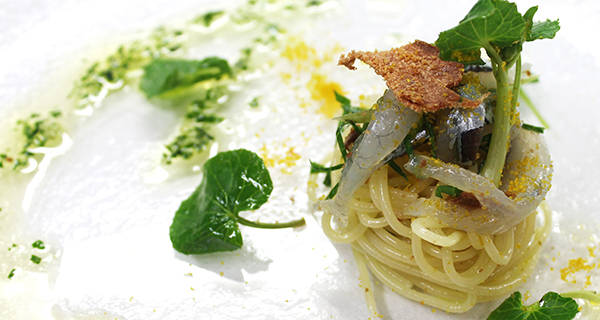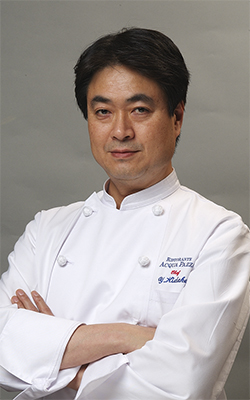
My name is Yoshimi Hidaka; I was born on October 4, 1957. I made my way over to the home of Italian cuisine (Italy) after being further taken aback by the charm of Italian food at an Italian restaurant in Japan called Ristorante Hanada. During the 3-year period of 1986-1989, I trained at a total of 14 restaurants located all over Italy, from the north to the south; these included the well-known establishments Enoteca Pinchiorri restaurant in Florence, Gualtiero Marchesi restaurant in Milan, and Dal Pescatore restaurant in Canneto Sull’Oglio (Mantua).  My realization is that the charm of Italian cuisine lies in the fact that it’s comprised of local dishes using local ingredients found in the various regions. After returning to Japan, I worked as executive chef at the well-known establishment Ristorante Yamazaki. In 1990, I opened and worked as master chef at ACQUA PAZZA in Tokyo’s Azabu district; the restaurant was named after the dish I found myself most impressed with during my time training in Italy. Right now, I am owner and chef at ACQUA PAZZA (which has relocated to Tokyo’s Hiroo district). As a chef representing Italian cuisine in Japan, I have been the recipient of solid acclaim both in Japan and abroad.
My realization is that the charm of Italian cuisine lies in the fact that it’s comprised of local dishes using local ingredients found in the various regions. After returning to Japan, I worked as executive chef at the well-known establishment Ristorante Yamazaki. In 1990, I opened and worked as master chef at ACQUA PAZZA in Tokyo’s Azabu district; the restaurant was named after the dish I found myself most impressed with during my time training in Italy. Right now, I am owner and chef at ACQUA PAZZA (which has relocated to Tokyo’s Hiroo district). As a chef representing Italian cuisine in Japan, I have been the recipient of solid acclaim both in Japan and abroad.
Chef, how do you define your cuisine and who are your targets (food lovers, Italians, Japanese…)? What is your philosophy and mission of cooking?
By using seasonal ingredients available during each of Japan’s four seasons and combining them with Italian seasonings (such as olive oil, balsamic vinegar, and processed tomato products), I have aimed to create a Tokyo-born “Cucina Tokyonese” for Italian cuisine which utilizes the flavor of Japanese seasonal ingredients. I want all Japanese people who greatly love both Italy and Italian cuisine, as well as people around the world (including Italians who love Japan), to get a taste of the new Cucina Tokyonese approach that I’ve come up with.
How and when did you discover De Cecco pasta? What features distinguish De Cecco’s products from other Italian and international pasta?
At Ristorante Hanada, where I trained in Japan, I had the chance to relish an aglio, olio, e pepperoncino dish which used De Cecco pasta; I was impressed with the flavor of the wheat, with the way that the sauce and noodles intertwined, as well as with the al dente texture. I was convinced of the fact that De Cecco is an extremely well-known pasta in Italy as it’s praised by many chefs and because it was also used at the 14 restaurants where I trained during my time in Italy. Above all, the charm of De Cecco pasta lies in the natural zest of the wheat itself which comprises the pasta, the flavor, as well as the way in which the sauce intertwines with pasta that’s produced using bronze dies. This charm has been well-conveyed to customers in Japan as well, where De Cecco has also secured a solid position as a top-of-the-line pasta.
What is your favorite De Cecco’s pasta?
Each De Cecco pasta product has its own charm, but those which I particularly like are spaghetti, fusilli, bucatini, and Filippo Series linguine.
The recipe – Chilled Fedelini with Sayori & Wasabi with Karasumi
Ingredients (Serves 2)
・Fedelini・・・・・・・・・・・・・・・・・・・・40g
・Sayori Japanese halfbeak (raw)・・・・・・・・・half cut
・Wasabi Leaf・・・・・・・・・・・・・・・・・・40g
・Wasabi Flower・・・・・・・・・・・・・・・・・40g
・Real wasabi (grated)・・・・・・・・・・・・・・10g
・Salt・・・・・・・・・・・・・・・・・・・・・・a pinch
・EXV Olive Oil・・・・・・・・・・・・・・・・・・as desired
・Tuna Karasumi (sliced)・・・・・・・・・・・・・as desired
・Karasumi Powder・・・・・・・・・・・・・・・・as desired
Directions
1. Lightly salt the wasabi stalk and let it rest for 2 to 3 hours. Boil in hot water around 80℃, then place in ice water (this process will increase the wasabi’s aroma).
2. Cut the wasabi leaf and wasabi flower stalks into thin pieces. Combine with the grated real wasabi, salt, and EXV olive oil to create the sauce.
3. Boil the fedelini, then place in ice water. Drain well, then combine with the sauce prepared in step 2, and the karasumi powder.
4. Transfer to your serving plate.
5. Add the wasabi flower, sliced sayori, and tuna karasumi to the pasta plate to complete.

